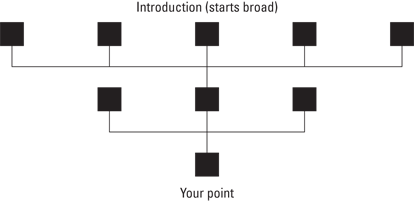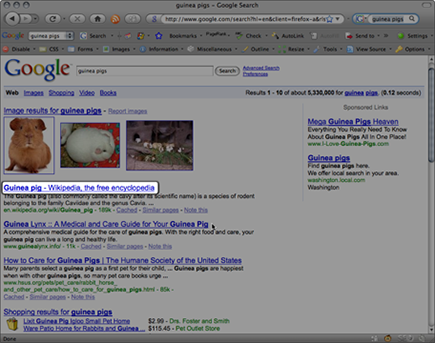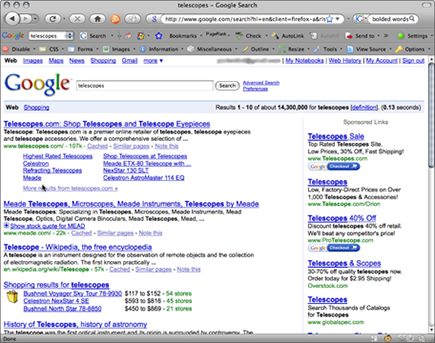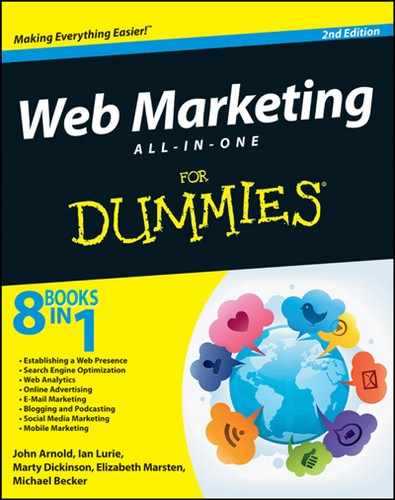Chapter 6: Writing Great Copy for Search Engines (And Readers!)
In This Chapter
![]() Writing online copy that attracts customers, boosts sales, and helps grow your business
Writing online copy that attracts customers, boosts sales, and helps grow your business
![]() Writing title tags and headings (that people will click)
Writing title tags and headings (that people will click)
![]() Setting a writing routine
Setting a writing routine
Like it or not, search engines care about words, so you’re going to have to put your hands on a keyboard and write some stuff about your company or hire someone else to do it.
Keep the following in mind:
• Writing great copy takes time and practice, not necessarily natural talent.
• Hiring someone else to write is an option, but it’s going to cost you. If you pay $5 for a page of copy, it will read like you paid $5 for it — lousy.
• Setting a routine makes writing easier.
In this chapter, you find some tips for writing great copy that both search engines and your visitors will like.
Writing Online Copy
You haven’t even started writing yet, but two thoughts are probably going through your mind:
“I don’t have anything to write about!”
and
“How many times should I repeat a key phrase on a page?”
You spend every day immersed in your business, so it might feel routine to you, but for your customers, it’s a whole new world. You have a wealth of knowledge and information they’ve never seen or have forgotten. If you can clearly communicate that to them, you’ll attract loyal customers. Even better, you’ll demonstrate relevance and move up in the search rankings, too.
Avoiding stop and filter words
Stop words are words that search engines typically ignore in your search, including those shown in the following list.
|
a |
in |
where |
|
about |
is |
who |
|
an |
it |
will |
|
are |
la |
with |
|
as |
of |
www |
|
at |
on |
|
|
be |
or |
|
|
by |
that |
|
|
com |
the |
|
|
de |
this |
|
|
en |
to |
|
|
for |
und |
|
|
from |
was |
|
|
how |
what |
|
|
I |
when |
Although stop words don’t directly hurt your attempts to get a high ranking, they don’t help either.
“Our bicycles are really great, and anyone who comes here will wonder why they didn’t before.”
becomes:
“Our bicycles really great anyone comes here wonder why they didn’t before.”
Filter words are those that may actually cause a search engine to ignore other content on the page. No one’s proven that search engines actually penalize sites for using specific terms, but you can safely assume that words commonly associated with some industries, such as adult entertainment, may hurt your rankings.
But what are the odds you’d end up writing naughty language on your website?
It’s easier than you think. Take this sentence for example:
“John was an adult who had a date with destiny.”
Adult and date, in close proximity, might just trigger some search filters.
And try this example:
“The bushtit is a small bird.”
The word — a real animal — likely got websites dinged. The problem went away as search engines matured and got better at determining the true meaning of words, but it’s a great example of accidental filter words.
Keeping it simple
Online, more than anywhere else, simple writing is best. People still have a tough time reading text on a screen. Most Internet users tend to scan for answers and keywords before they read.
So always look at how you can shorten what you’ve written. Here are a few tips and examples:
• Pare down the number of words whenever possible. “Then things went from bad to worse” can just as easily be “Things got a lot worse.”
• Avoid slang and colloquialisms. “They couldn’t see the forest for the trees” might also be “They were stuck on the details.”
• More syllables won’t make you sound smarter — folks will just skip the sentence altogether. “Our expertise is unrivaled in our industry” could read “We’re the best.”
Using active voice
Many of us were taught to write in the passive voice, like this.
It’s better to say, “Many of us learned to use passive voice.”
See the difference? Instead of some mysterious third party out there who taught us, the latter gets straight to the point. Active voice is always clearer, easier to read, and often far easier to optimize for a search engine.
Here are a few examples:
• Okay: “Bicycles are repaired by our mechanics” is fine, but it’s slow, wordy, and doesn’t include bicycle repair, which is the real target phrase.
• Better: Instead, try “Our mechanics perform top-notch bicycle repair.” It’s not actually a shorter sentence, but it reads better and it includes your target phrase.
• Okay: “Mixed-green salads are good for you!” That reads pretty well, but it misses a few opportunities to deliver more marketing punch, and if your target phrase is mixed-greens health benefits, you miss that opportunity, too.
• Better: You can use active voice and write, “You already know about mixed-greens’ health benefits.”
• Okay: “We are Frank’s favorite CPA firm.”
• Better: “Frank says, ‘I love this CPA firm!’” No big difference, SEO-wise, but it’s a shorter sentence and makes Frank the speaker — the words are coming directly from him because active voice is used.
Getting to the point
Standard college and primary school writing style tells you to write according to an outline, as shown in Figure 6-1.
Figure 6-1: Typical “funnel” writing style.

However, search engines lend more weight to text at the top of the page, not at the bottom. If your point is all the way at the bottom of the page, two things happen:
• Search engines accord it less relevance. If your point includes your target phrase, you want to move it up.
• Readers are likely to give up before they get all the way down the page. Your point is often your value proposition. You want to say that first.
So, make your point and state your value proposition at the very top of the page, not at the bottom. Compare these two brief product descriptions:
Our bicycle tires are made by hand. They also feature a Kevlar belt. They use our patented long-wear formula. And they are rigorously tested by our laboratory. So they’ll remain flat-proof for years.
They’re flat-proof? Why didn’t you say that in the first place! Try this instead:
Our flat-proof bicycle tires feature a Kevlar belt. They’re handmade and rigorously tested by our manufacturing team. With our patented long-wear formula, they’ll remain flat-proof for years!
Much better. Not only does this version tell readers that these are flat-proof bicycle tires, but it also worked the value proposition right into the first sentence, so search engines will give this page high relevance for the phrase flat-proof bicycle tires.
Writing scannable copy
The description of the flat-proof bicycle tires from the previous section can be better though: You can make it more scannable. Remember, online readers tend to scan, not read. So, breaking your most important points into separate bullets and short, punchy paragraphs can help your readers. Using this format also provides a structure that search engines can more easily filter for the most important points.
You can revise the last example from the preceding section this way:
Our flat-proof bicycle tires
• Feature a Kevlar belt
• Are handmade
• Are rigorously tested
• Will remain flat-proof for years, thanks to our long-wear formula
You can see how much easier it is for a reader to pull out the important features of this product.
Finding the right keyword density
So how many times should you use a keyword?
There’s no solid answer, but these steps should give you a feel for what the right density is for you:
1. Write your copy first, without considering your key phrase.
2. Look at your competitors’ pages.
How many words do they have on a page? How many times do they repeat their target phrases?
3. Review what you wrote.
Try to include 10 percent more copy than your competitor did.
4. Use the same keyword density that your competitor did, with a maximum density of 3 to 4 percent.
Any more than that sounds ridiculous. Look for places where you used synonyms that you can easily replace with your target phrase.
Writing a Great Title Tag
Writing a title tag involves more than putting your keywords first. Search engines display the keyword tag at the top of each item in the search engine result pages (SERPs). Figure 6-2 shows an example.
Figure 6-2: The title tag in a SERPs listing.

A well-written title tag might increase the odds that a searching customer will click your listing. If you balance the need for SEO with the need for an impactful title tag, you generally get more clicks and a higher ranking.
Getting past your brand
First, don’t put your brand first. Your brand will be front and center when customers land on your website. In the meantime, focus on getting a high ranking and a click.
Here’s an example:
<title>Harrison’s Bikes: Seattle Bicycle Repair</title>
The brand went first. That placement reduces the relevance of the tag for Seattle bicycle repair because search engines more heavily weight the first words. Plus, readers won’t see the benefit in clicking unless they read the whole title tag. Why make them work for it? Instead, use this:
<title>Seattle Bicycle Repair: Harrison’s Bikes</title>
The key phrase is first. Even better:
<title>Seattle Bicycle Repair and Sales</title>
It leaves out the brand in favor of another keyword.
Avoiding keyword stuffing
Try not to put a given keyword into a title tag more than once — twice if absolutely necessary. Search engines have long hated title tags like this:
<title>Bicycles and Bicycle Repair with Bicycle Sales at Harrison’s Bicycles</title>
Plus, doing so is a terrible way to introduce customers to your company — the writing is poor and is hard to read.
Telling your story
Your title tag may well be the very first thing your customers see. It should say something important about you. If something sets you or your business apart — an award, a unique service, or something else — try to work it into the tag:
<title>Bicycle Repair and Sales – Rated Seattle’s Number 1 Bike Shop: Harrison’s Bicycles</title>
Note that this title tag doesn’t repeat any keywords. To a search engine, bicycle and bicycles are different words.
This title tag maximizes the chances that a customer will click. Rated No. 1? Sign me up!
Making it readable
After all this work, it pays to reread the title tag and make sure that it makes sense.
Like link text, a title tag should make sense all on its own. It needs to be totally self-contained. So,
<title>Bicycle Repair and Sales</title>
is okay, but it’s missing important information, such as the location. The tag
<title>Seattle Bicycle Repair and Sales</title>
is far better. Now customers know it’s in Seattle. Plus, search engines award greater relevance in local searches because Seattle is in the title tag.
Make sure that your title tag can stand on its own. It’ll probably have to at some point. If folks create a link to your site, they might use the title tag as the link text. If your title tag clearly defines the page it titles, the link will clearly describe the page to which it points.
Writing a Great Description Tag
Meta description tags don’t directly affect ranking. But a well-written description tag can cause more searchers to click through to your website. Search engines often use the description tag as the snippet in a search listing, as shown in Figure 6-3.
Figure 6-3: A search snippet using a meta description tag.

So, you can edit the description tag and optimize it for your customers.
Here’s an example, which also shows the code for a description tag:
<meta name=”description” content=”Harrison’s Bike Shop is located in Seattle’s Alki neighborhood. Our award-winning bicycle repair mechanics can fix any problem! In business since 1902. Open 7 days a week. Call us at 222.333.4444.”/>
Why bother inserting bicycle repair in front of mechanics? It seems wordy, but search engines boldface the words you search for in the snippet, as shown in Figure 6-4. That will increase the chances of a click.
Figure 6-4: Bold keywords in a search result.

If your call to action is Order online or Call for more information, put that in your description tag, too. If your competitors’ websites don’t say “order online” and you do, you’ve just gained an advantage.
Connecting Headlines to Copy
The heading is the first text your customers see. Like your title tag, it needs to stand on its own and contain your key phrase.
Unlike your title tag, though, it should directly support the paragraph beneath it. The title tag can be relevant to the entire page without referring to the first paragraph on that page. But even a level 1 heading needs to have some connection with the first paragraph of copy.
If your writing gets to the point (see the section “Getting to the point,” earlier in this chapter), this shouldn’t be a problem. Your point should be clear in the paragraph immediately following the headline.
Here’s an example: Assume that the first paragraph on the page discusses the award-winning service of Harrison’s Bikes. The heading could be
<h1>Award-Winning Seattle Bicycle Repair</h1>
That ties into the paragraph copy, connects to the title tag, and includes the target key phrase Seattle bicycle repair.
Avoiding a Verbal Meltdown
Title tags, headings, descriptions, keyword density . . . it’s easy to forget about the writing.
Avoid a verbal meltdown like this:
“Bicycle repair at our Seattle bicycle shop is award-winning. Our bicycle repair experts will repair your bicycle 7 days a week. . . .”
Setting a Writing Routine
One other way to avoid a verbal meltdown is to set a routine. Maybe you can write about your company three times a week for 30 minutes. You don’t worry too much about what you’re writing. Just spend 30 minutes writing down what comes to mind.
You might come up with copy that you can use (with some editing, of course) or a nice list of ideas you can use later.
Follow these steps to set your writing routine:
1. Find at least 30 minutes a week and put it into your calendar.
This time is absolutely sacred. Don’t surrender it to meetings, television, or anything else.
2. Get an egg timer or some other way to keep time.
3. Go someplace quiet, if you can, or put on headphones to block out distractions.
4. Set the timer.
5. Write for 30 minutes straight.
Do not stop to ponder sentences or decide whether you should use toward or towards. Just write, write, write. The idea is to get a complete brain dump.
6. Stop at the end of the 30 minutes.
7. Later that day or the next, review what you wrote.
It might be ready to post to your website or blog. If it is, pass it to a friend for a quick read. He might catch typos you missed. (Typos matter — search for philsophy online, and you’ll see all the sites that misspelled philosophy. Those sites can’t gain a high ranking for the correct spelling.)
If it’s not ready to post, keep it anyway. Fiddle with it. See whether you can build on one or two paragraphs to create a complete page.

 As for the second question: The maddening answer, borrowed a bit from Mozart, is “Precisely as many times as necessary. No more, no less.” Search engines won’t tell you “make sure that you use 2 percent keyword density!” Remember that they want relevance — not keyword density.
As for the second question: The maddening answer, borrowed a bit from Mozart, is “Precisely as many times as necessary. No more, no less.” Search engines won’t tell you “make sure that you use 2 percent keyword density!” Remember that they want relevance — not keyword density. So, loading up on stop words can have unexpected results. Try to minimize stop words. It’s good technique, too. Stop words tend to slow a reader’s progress as he tries to learn what you’re telling him. Fewer stop words mean clearer writing.
So, loading up on stop words can have unexpected results. Try to minimize stop words. It’s good technique, too. Stop words tend to slow a reader’s progress as he tries to learn what you’re telling him. Fewer stop words mean clearer writing. Stop
Stop 